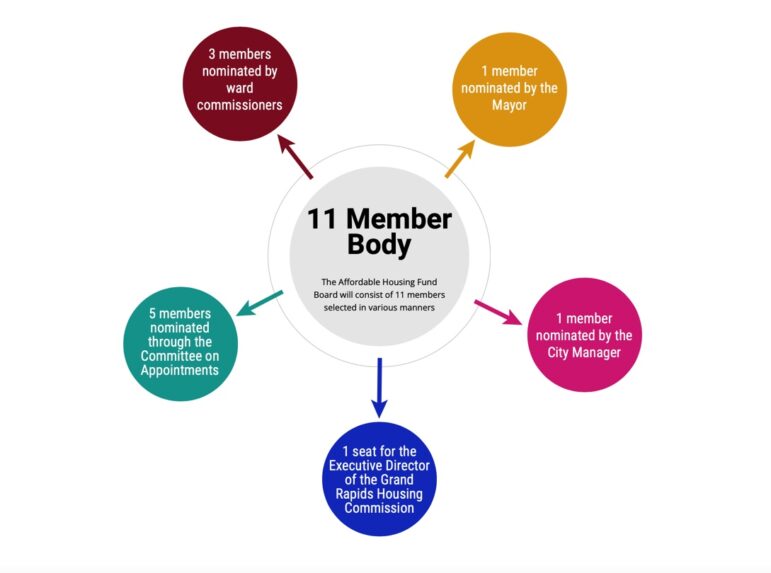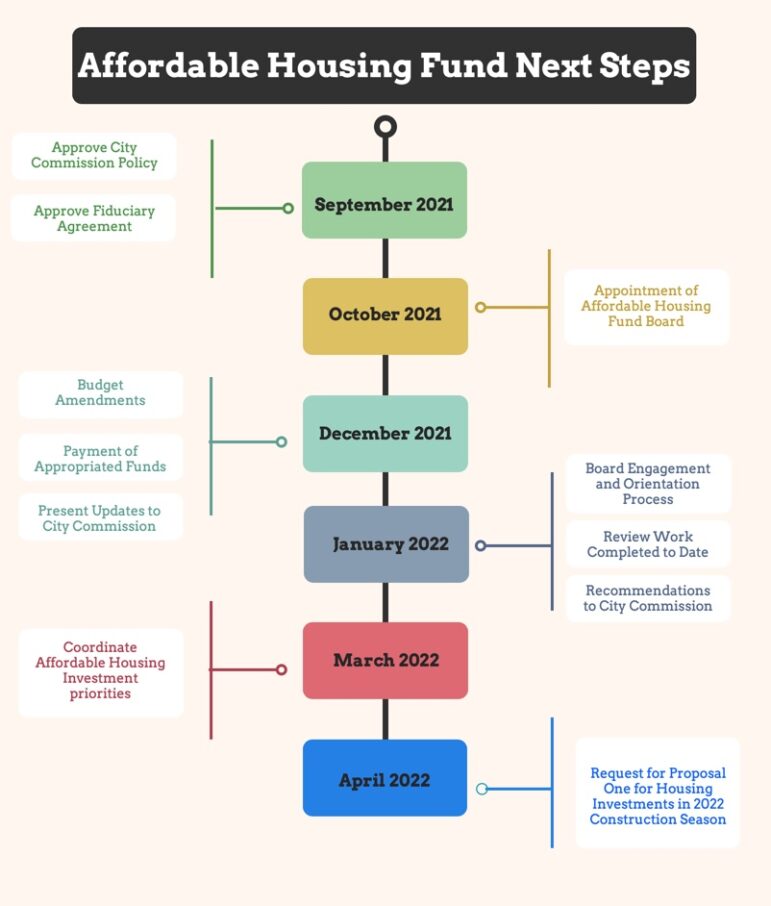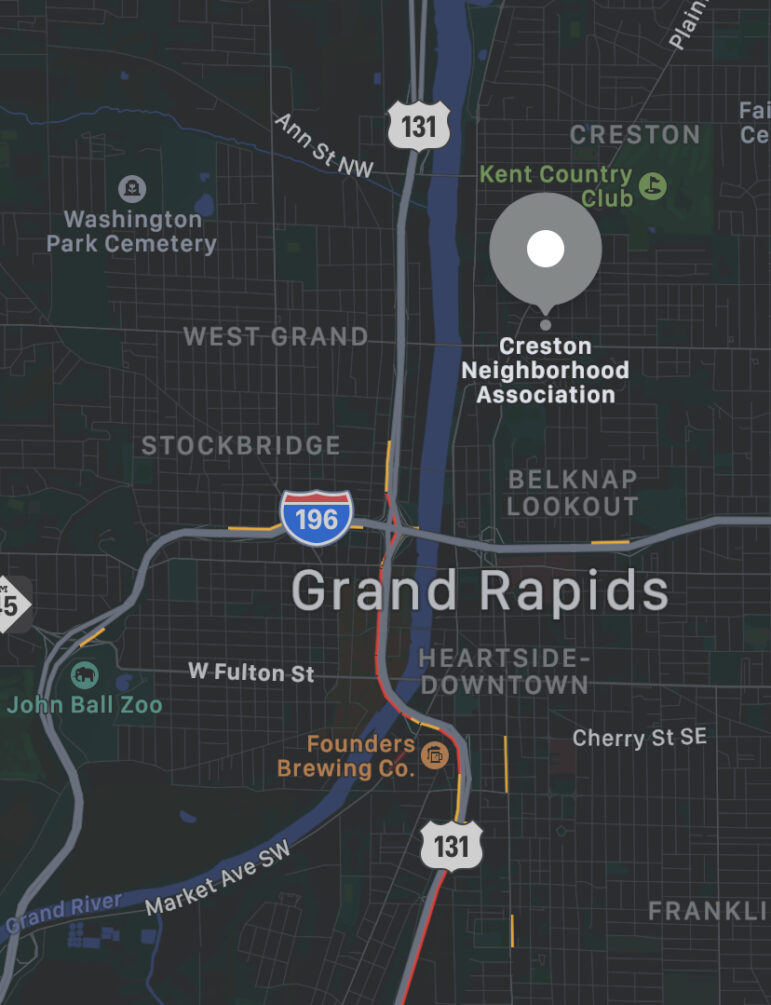On Sept. 14 the Grand Rapids City Commission approved a proposal to create an Affordable Housing Fund. The presentation of the fund included data showing that approximately 25,000 Grand Rapids households spend over 30% of their income on housing and approximately 13,000 households spend over 50% or more.
According to the Affordable Housing Fund Policy Overview, the program will consist of an 11 member board responsible for developing investment plans and collecting and allocating funds.
The board has yet to be selected, but the presentation lays out a plan for selecting board members.

Created by Kristia Postema. Information obtained from the City of Grand Rapids website.
The guidelines for how the 11-member body will be selected.Housing Next and The Affordable Housing Fund
According to Ryan Kilpatrick, a contractor for the City of Grand Rapids through an organization called Housing Next, the city has been working on developing an affordable housing plan for a number of years.
Kilpatrick said that Housing Next conducted a housing needs assessment for Grand Rapids last year.
“What we found is that more than 32,000 households are spending more than 30% of their income on housing,” Kilpatrick said. “We have a need for an additional 9,000 housing units, about half of which need to be affordable to households earning less than 80% area median income.”
For a clip of Kilpatrick’s interview, click here.
According to Grand Rapids Second Ward City Commissioner Milinda Ysasi, investing in housing for those without generational wealth and low to median income levels is a process involving many contributors.
“We know that housing is one of the biggest issues facing the city,” Ysasi said. “We know we can’t do it alone so we are grateful for our community partners.”
Ysasi said that she wants the housing provided by the Affordable Housing Fund to be “equitable and safe.”

Created by Kristia Postema. Information obtained from the City of Grand Rapids website.
Affordable Housing Fund next steps following approval of the fund.Funding for the Affordable Housing Fund
Kilpatrick said that current market rates aren’t able to solve the city’s current housing needs.
“The city decided that it really needed to have an extra source of subsidy at the local level that could help contribute to the additional housing supply at affordable rates,” Kilpatrick said. “The city has already set aside a little over $875,000 that is coming from a previous allocation.”
The city has also developed two additional funding sources, Kilpatrick said.
“One uses a portion of the payment that affordable housing providers already make to the city,” Kilpatrick said. “Instead of those affordable housing providers paying their traditional tax bill, they pay something called a ‘payment in lieu of taxes’ and a portion of that annual payment will go into the housing fund.”
Kilpatrick said the second source of additional funding will come from publicly owned parcels that are surplus property and could be sold to potential affordable housing developers.
“Any excess sale proceeds for the sale of public land could also be invested into the housing fund,” Kilpatrick said.
Neighborhoods of focus
The Affordable Housing fund is still in the preliminary stages of development, but Kilpatrick assumes that once the Affordable Housing Fund Board is appointed they will look into developing affordable housing in “neighborhoods of focus.”
Kilpatrick described “neighborhoods of focus” as “neighborhoods that have been historically under-invested in and have high rates of low-income groups.”
According to Kymie Spring, the Community Organizer for Grand Rapids’ Creston Neighborhood Association, lack of affordable housing is a major issue for residents of Creston.
Creston Neighborhood Association

Apple Maps
A map of Downtown Grand Rapids illustrating where the Creston Neighborhood Association is in relation to the Grand River, Heartside Downtown, Stockbridge, West Grand and Creston.Spring said that the neighborhood meets yearly to assess issues and possible improvements. Each year Spring conducts an exercise called the “Dot Exercise.” For this exercise, she lists various issues on posters and hangs them on the walls. Residents are allowed five dots to put next to the improvements they deem most important.
“To generalize, people support affordable housing and the environment by leaps and bounds,” Spring said. “We want to see affordable housing funding contributing to building homes that are extremely energy efficient and as close to carbon-neutral as possible.”
Spring wants to see affordable housing developments in the Creston neighborhood so future generations can afford to live there.
“Our neighbors do not want to see our neighborhood getting gentrified,” Spring said. “They have kids that might want to live close to their parents and grandparents when they grow up.”
Housing difficulties for residents
Spring said that it is extremely difficult to find housing in all of Grand Rapids including the Creston neighborhood.
“The average median income in [Creston’s] lowest-income area is $30,000,” Spring said. “If people can’t find housing that they can afford they end up renting from scummy landlords.”
According to Spring, the only places that low-income families are able to find right now are often unsafe and unclean.
“We want them to have modest, affordable, safe places to live,” Spring said.